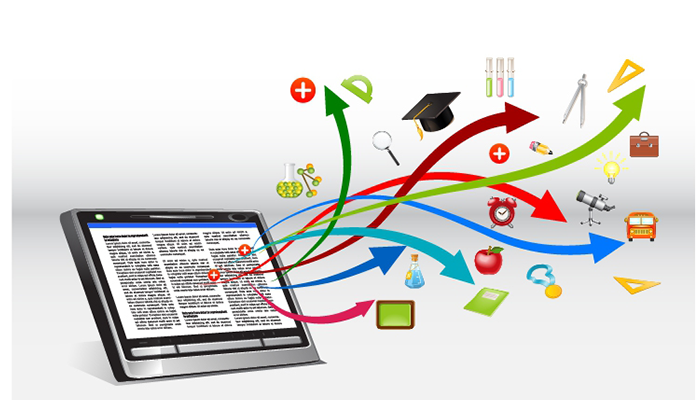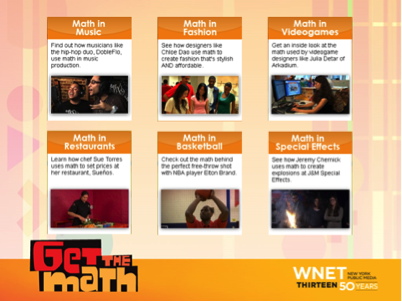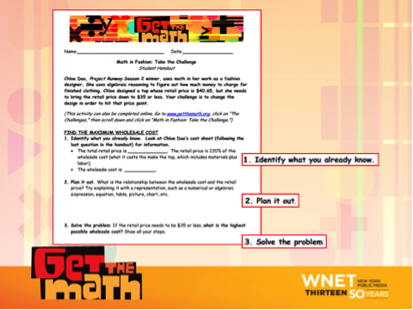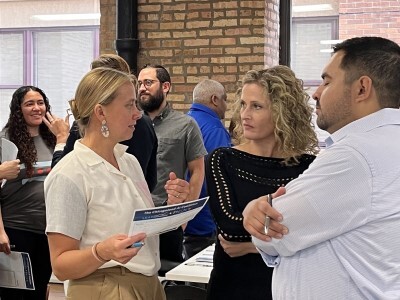Technology Tools
Increasing Teacher Engagement: Digital Resources for Algebraic Reasoning (Part 2)
Topics

Educators often take advantage of educational technologies as they make the shifts in instruction, teacher roles, and learning experiences that next gen learning requires. Technology should not lead the design of learning, but when educators use it to personalize and enrich learning, it has the potential to accelerate mastery of critical content and skills by all students.
Deborah Ives describes how WNET/Thirteen expanded the Common Core-aligned algebra content covered by Get the Math in response to teachers’ requests for even greater integration into their curriculum.
Support for NGLC: Building Deeper Learning Competencies
In our last post, we shared our NGLC project, Get the Math, a flexible digital resource with an approach that allows learners to take ownership over the learning process, completing challenges and assessment activity sheets at their own pace and using their own methods. Throughout each module, students are encouraged to discuss and work through problem-solving strategies with their peers, increasing understanding of the standards-based algebra content while simultaneously developing deeper learning competencies. GTM is a competency-based tool that can be used with learners of algebra no matter their grade level; videos and challenges are narrated in an age-appropriate and socially relevant manner that will appeal to teens in grades 7-12.
A “Day in the Life”
Each module follows a similar structure. After a brief introduction to how math is used in each professional’s daily work life, students can try related math challenges themselves using interactive tools and hints before watching a video that shows the GTM student teams’ solutions. Students can then use additional interactive challenges to deepen their understanding of the algebraic concepts explored. Lesson plans help teachers integrate GTMtools into their own curriculum and assessment tools provide ongoing feedback on student progress.
In today’s post, we begin with the expansion of Get the Math based on feedback from students and teachers, as well as sharing a summary of outside research and lessons learned.
Get the Math 2.0
Our involvement with NGLC enabled us to expand the scope of Algebra I content covered by the project through the creation of additional modules, Basketball, Restaurants, and Special Effects, allowing us to include a greater span of the curriculum to address teachers’ concerns. We were also able to significantly extend the reach of Get the Math to many more students and educators to support the teaching and learning of Common Core-aligned Content and Math Practices, with a focus on reasoning and sense making, in classrooms across the country. In our targeted implementation efforts in New Jersey, we reached approximately 2,000 students and 50 teachers who utilized the Get the Math modules and support materials during the 2011-12 school year in our partner districts. We also were able to create a broadcast version of the new Get the Math content that will air in 2013. As Get the Math ;was recently nominated for a Daytime Emmy for “Outstanding New Approaches – Original Daytime Program,” we anticipate increased visibility on PBS stations!

Furthermore, attending events organized by NGLC enabled us to be more thoughtful about plans and opportunities for supporting teachers’ understanding of the CCSS Mathematical Practices, as well as their content knowledge. For example, the Common Core Convening held in April 2012 in Chicago provided greater insight into the implementation of the CCSS six-step modeling cycle directly from one of the CCSS authors, Jason Zimba. Teachers had requested additional scaffolding in the lesson plans to enable them to better understand how to engage their students in employing critical thinking skills and using multiple representations to solve problems in algebra. Specifically, what does teaching and learning reasoning and sense-making look like in a classroom? We redesigned the activity handouts with the CCSS modeling cycle explicitly embedded so teachers would have a resource where their students could practice the basic problem solving modeling cycle, have a wealth of embedded questioning techniques to employ, and access to performance tasks that reflect upcoming expectations aligned with the Common Core Assessments.

The lesson plans and handouts were redesigned to support teachers and students through the reasoning and sense making process. They can serve as a form of embedded assessment through questions that ask students to explain their thinking and strategies.
Research Outcomes
With the new design in place, an evaluation by MediaKidz contributed unique research and knowledge about the potential benefits of digital learning to the field of educators and educational media practitioners that can now be shared with teachers and administrators. The research found that GTM prompted more sophisticated algebraic reasoning and has the ability to engage at-risk students and impact their attitudes towards, and interest in, STEM learning. GTM is now a featured project of the Corporation for Public Broadcasting’s American Graduate public media initiative to address the high school dropout crisis.
Additional key findings:
- Get the Math succeeded in prompting more sophisticated algebraic reasoning performance than students exhibited previously.
- Students’ interest in learning more about the algebra topics and their interest in learning algebra via the multimedia format of Get the Math varied across the modules. Reasons for interest often stemmed from either: an interest in the subject matter, appreciating that Get the Math demonstrated real-world applications of algebra, or feeling that the format of Get the Math made it easier to learn.
- The greatest attitudinal impact of Get the Math was in helping students recognize ways in which algebra can be used outside of school. After using Get the Math, 64% of the students said they could name ways in which algebra is used in the real world.
- Teacher outcomes. Through our implementation and outreach efforts, teachers in schools across New Jersey and the country were able to integrate Get the Math into their classrooms and gain more comfort using the digital tools. According to the results of the independent summative evaluation, teachers generally rated Get the Math positively, with 65% to 75% rating it either “Good” or “Great” for educational value, appeal/engagement for students, and value/usefulness for teachers. In addition, when asked how easy or difficult it was for teachers to use Get the Math, 75% felt it was either “fairly easy” or “very easy” to use.
What We Learned
- Teachers are concerned about their students’ understanding of algebraic content. The Common Core State Standards for Mathematical Content are identified as “a balanced combination of procedure and understanding” (2010). Many teachers are seeking increased knowledge and support about new expectations for best practice with easy-to-use, innovative technological tools that inspire and motivate their students as they develop algebraic reasoning and sense-making, in addition to the use of traditional algorithms, to better meet upcoming assessments.
- We found it helpful to partner with the National Council of Teachers of Mathematics (NCTM), which has helped to position GTM as a resource that supports teachers in both CCSS Content and pedagogical knowledge. It was thanks to our partnership with NCTM that we were able to attract such a large audience for our December 2012 joint webinar—approximately 1,000 attended. Our partnership with NCTM and trainings conducted via PBS stations has enabled us to reach teachers who have a growing interest in resources that support the Common Core Math Practices. We found this to be more effective than going through school administrators. When we worked with administrators in New Jersey school districts to implement the GTM modules, the administrators were enthusiastic, but some teachers did not prioritize our materials because they were feeling pressure to prepare for new standardized tests imposed by the state.
- Teachers want resources that integrate into their curriculum. Our experience in New Jersey also showed us the importance of clear messaging and targeted training to ensure that educators understand how Get the Math resources can easily be integrated into their curriculum to support Common Core Content and Math Practices, rather than being merely a supplement or add-on that takes time away from core curriculum.
Get the Math is a rich, interactive, and flexible learning experience that is available free of charge to students, educators, schools, parents, and anyone else who chooses to use it. With support from NGLC, WNET continues to provide online professional development resources which will help teachers learn to use this valuable tool and integrate CCSS Content and Mathematical Practices into their classrooms. Training resources, including a video and webinar, will remain available on the GTM website indefinitely, ensuring that GTM will be accessible to teachers beyond those immediately reached through our partner organizations. As a free resource, GTM is and will continue to be available at cost levels equal to or lower than currently available instructional materials. Encouraging students to engage in the habit of attending to the process going on in their own minds while solving questions, and of explaining how they solve them is key to developing Reasoning Habits of Mind. Supporting teachers in their knowledge of effective pedagogy using digital resources is essential to bringing real world applications directly into the classroom to motivate students in making critical connections for reasoning and sense making.
Learn more about Get the Math at www.getthemath.org.
Learn more about Thirteen/WNET's grant project.




